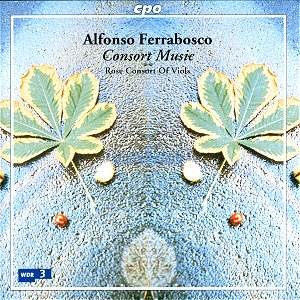Comparison recording:
Ferrabosco, viol fantasias, Fretwork.
Musical Heritage Society 11231K [North
America only, licensed from Saydisc]
Father and son pairs
in music are not all that rare; one
naturally thinks of J. S. Bach and sons,
and the Strausses and Couperins. The
Ferraboscos wrote music so similar that
it was not proven until recently that
there were actually two of them and
some of the pieces are still uncertainly
ascribed between them. In the service
of Queen Elizabeth I from 1562, Alfonso
Ferrabosco I became the single most
influential Italian musician at court.
When he left England in 1578, his son
Alfonso Ferrabosco (II) was, some say,
held hostage upon his return. At any
rate, he stepped into his father’s shoes,
eventually becoming royal music tutor
to Prince Charles I, accounting for
the continuous presence of a musician
by that name at court.
Viol consort music
can sound like a hushed conversation
in a sinusitis clinic, or funeral music
played on an accordion. But here we
have a virtuoso group who can produce
the rich variety of tone that is possible.
It comprises players who know their
instruments and the music and who produce
a beautiful consonant blending of sound.
Most of this music owes a great debt
to organ composition style and the players
tend to find a rich chord and let it
resonate.
The performances of
some of this same music by the viol
consort Fretwork are considerably more
articulated, brighter in mood, faster
in tempo, and altogether more entertaining.
I have listened to this cpo
disk a number of times and regret to
find that, while it is suitable for
meditation or background music, it is
so even in tone that it is difficult
to keep one’s attention on it, or tell
one piece from another. The Fantasias
heard here do not have the intellectual
integrity of those by William Byrd and
others, however the music is not so
much at fault as the subtlety of the
performers’ phrasing and even tone.
Paul Shoemaker







